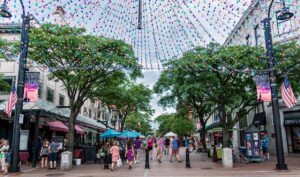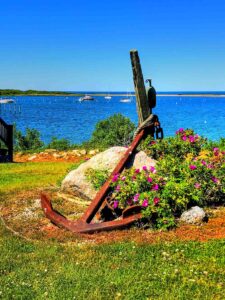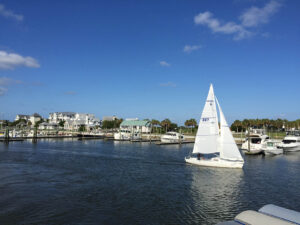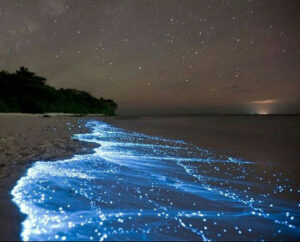Costa Rica. If you have the slightest need for outdoor adventure pulsing through your body, it should be on your bucket list of places to visit.
This Central American nation covering only 0.03% of the world’s surface boasts 6% of its total biodiversity. Borderded by both the Pacific Ocean and Caribbean Sea, only four hours apart by car or 45 minutes by plane, it is an environmental paradise which still sports virgin forests and clean waters while offering enough infrastructure to support a tourist draw of more than a million per year.
From jungle forests to whitewater rivers, tremendous waterfalls and a largely undeveloped coastline with innumerable nooks and crannies for snorkelers, surfers, boaters and anglers to investgate, the eco-tourism call rings loud and clear here.
OPPORTUNITY ABOUNDS
Like all places recently “discovered” in today’s world, things here are changing. The population is increasing, tourism is booming, businesses are growing. Yet much of Costa Rica remains remote, untouched and unspoiled. Fully 25% of the country has been set aside as protective parkland and reserves to safeguard the beautiful and lush environs from deforestation, logging and development.
Within these boundaries lie many diverse habits including rainforests, swamplands, mountains, cloud forests, active volcanoes, hot springs, caves and even entire harbors and islands. From one end of the country to the other, the opportunity to observe a diverse array of wildlife and marine species while enjoying outdoor activities like boating, fishing, hiking, sight-seeing, snorkeling, diving, surfing and eco-touring ranks among the finest in the world.
But with so many possibilities the thought of exploring Costa Rica can also be overwhelming. I mean, where do you start?
“It helps,” says Glen Mumford of Blue Water Sport fishing Charters, “if you work with a travel pro that deals frequently with Costa Rica to customize your trip. Each one has contacts with a proven record of providing what visitors need and want, which really helps narrow down the selection process.”
Capt. Gene Kelly of Tropical Fishing Adventures, agrees. “Working with a booking service can help put you in the right place at the right time of year for the sh you want to catch, sights you want to see or adventures you want to experience. Costa Rica may be a small country, but it can seem huge if you don’t have any connections.”
Both Mumford and Kelly specialize in setting up trips for anglers, but either can also turn you on to the best deals, most gorgeous beaches and top tours, sights or activities for any outdoors endeavors in this tropical tourist hot spot.
UNPACKING COSTA RICA
Indeed, one way to break down the opportunities here is to look at the country in terms of regions. With fishing, for example, the Pacific Coast specializes in o shore action with marlin, swordfish, sailfish and other big game pelagics. Further, the northern section sees its best catches in the spring, summer and fall while the southern section is best from November through March. By comparison, the Atlantic/Caribbean side is where you want to go for tarpon, snook and other inshore species. Both coasts offer tremendous fishing, but there are nuances to the game that first-time visitors sometimes underestimate.
Both the east and west coasts are accessible by boat and by air from Juan Santamaria International Airport (SJO) which is the only entry point in the country from which local flights can easily connect. Liberia International Airport (LIR) airport is another option for landing if you are headed to the west coast and don’t need an additional flight.
In general, the most popular Costa Rica ports reside on the Pacific side, so let’s take a quick virtual tour of that stretch for this introduction.
GUANACASTE
Approaching from the north, the providence of Guanacaste, which encompasses the entire north Pacific Coast of Costa Rica, is the first port of entry and lies less than an hour from Liberia International Airport. One of the least populated sectors of Costa Rica, this region is also the most visited.
Here you’ll find beautiful beaches for sunbathing, great surfing and sailing, several large all-inclusive resorts on the Papagayo Gulf, numerous first-rate restaurants plus tons of marine life — especially in the Isla Catalina area, Playas del Coco and Playa Ocotal. Interestingly, fishing is not a big draw here even though it is quite good as peak season for o shore action runs May through October.
Marina Papagayo is where you’ll want to head if arriving by boat. With a clear approach and 38 feet of water at the docks, this well-appointed marina accommodates even superyachts up to 280 feet. Many larger vessels, in fact, choose this location as a staging stop for trips to the Galapagos Islands, Isla del Coco and the South Pacific.
The marina is actually part of Peninsula Papagayo, a 2,300-acre development with a Four Seasons Resort, an Arnold Palmer signature golf course, its own private beach club at Prieta Beach and a Hyatt Andaz right next door.
JACO
Continuing south to the central portion of the coast, Los Suenos is the next logical port to visit. Another easy approach with plenty of deep water, this is a prime tourist location with first-rate accommodations, gift shops featuring all the t-shirts and knick-knacks you can carry home, plus fine dining, golf and plenty of condos.
The marina choice is simple here, go with Los Suenos Marina, located in neighboring Herradura Bay. is was the first big, fully outfitted marina in Costa Rica with floating dock systems, great service and all the amenities you might expect. You’ll find great restaurants in town, a huge beach just 15-minutes away, plus surfing, horseback riding, zip lining and various eco tours.
“This is is one of the more ‘Americanized’ ports, so if you want a place with a somewhat familiar feel, you’ll enjoy it here,” says Kelly. “ There are gated communities, palm tree-lined streets, and although the town is only a few square blocks, it bustles. For fishing, this is where things really start to get interesting in the winter months with reliably great off shore action.”
QUEPOS
Less than 50 miles to the south lies the town of Quepos, which Kelly calls his favorite. “The big difference between Jaco and Quepos,” he explains, “is that the latter is smaller, more intimate and surrounded by forest while Jaco is far more developed. In addition to super offshore fishing, you can take a catamaran or enjoy a Segway, SUP or jet ski tour. You can also rent your own boat or step aboard a sunset cruise.”
Like Jaco, there is a full fishing fleet here but the boats tend to run a little smaller and operations are more laid back. Still, the current fleet has no problems dealing with the generally calm waters in this area.
While visiting Quepos, be sure to explore Manuel Antonio National Park which encompasses rugged rainforest, white-sand beaches and coral reefs. Renown for its vast diversity of tropical plants and wildlife, it features three-toed sloths and endangered white-faced capuchin monkeys amongst its amazing array of 109 mammalian and 184 species of birds. It also sports two beautiful crescent-shaped white sand beaches. Don’t expect to hike alone in this park however; it’s so busy that the main trail recently had to be expanded from a two-person access to full road-width.
With over 200 slips, Central America’s only 200-ton travel lift and a full-service yacht yard, Marina Pez Vela (marinapezvela. com) makes a great home base for boaters.
GOLFITO
The southernmost stretch of Pacific Coast is known as the Golfito region. Hands down, this is nirvana for anglers. Expect to catch marlin, sailfish, tuna and dorado in offshore waters while targeting rooster fish, snappers, bluefin, trevally, jack crevalle, amberjack, pompano and more on the inshore scene.
If you decide to captain yourself to this stretch of fishing paradise, Banana Bay Marina (bananabaymarinagol to.com) is the place to tie up. Located at the edge of a tropical rainforest in the city of Golfito, it’s separated from the open Pacific by Golfo Dulce, accommodating boats up to 120 feet, and staff can provide ship agency, port clearance, customs and immigration services on site.
“The South Pacific coast of Costa Rica is one of the few places in the world where fisherman can catch three species of marlin in just one day,” says Jorge Martin, a manager at the marina. “Plus, this region is one of the most biologically intense places on earth. The area contains 50% of the ora and fauna of Costa Rica. In addition to fishing, popular activities include world class surfing, horseback riding, kayaking, diving, hiking to mangroves and bird watching.”
For dining, the marina restaurant provides tastes of European, American and Costa Rican cuisine. You might also try Casa Roland which specializes in international cuisine or Mar y Luna which is famous for its fresh seafood. Casa Roland also offers lodging. For gifts, souvenirs and boat fishing gear, take a trip to the city port.
The newly opened Golfito Marina Village & Resort (golfito marinavillage.com) are also worthy of investigation. The latter offers the rare opportunity to own and inhabit your very own private island with full views of Golfito Bay and the ocean. A cool four million gets you the keys a 3,500-sq. ft., custom-designed luxury home one of the several island jewels being offered for sale. Dock owners receive membership to Golfito Marina Village’s exclusive Yacht Club, and all the features and amenities of a world-class marina.
WHEN TO GO
Costa Rica’s tropical climate makes it a terrific year-round destination. Most travelers prefer to visit during the dry season (December-April). However, there are lighter crowds and lower travel prices during the “green” season (May-November).
WHERE TO DOCK
- Marina Papagayo, Guanacaste
- Los Suenos Resort and Marina, Playa Herradura
- Marina Pez Vela, Quepos
- Banana Bay Marina, Golfito
- Golfito Marina Village & Resort, Golfito
AIRPORTS
- Juan Santamaria International Airport (SJO)
- Liberia International Airport (LIR)
DOCUMENTS AND CASH EXCHANGE
Visitors traveling to Costa Rica need a passport that is valid for the length of their stay. Expect to pay a small airport departure tax as well. U.S. dollars are widely accepted in Costa Rica. Carrying small bills to pay for souvenirs and for tipping will work to your advantage.
MUST SEE OR DO
- Manuel Antonio National Park, Quepos Impressive landscapes, white-sand beaches, amazing plant and animal diversity. Costa Rica’s most popular National Park.
- Arenal Volcano National Park, San Carlos Arenal Volcano National Park features hot springs, two active volcanoes and cooled lava fields, plus diverse wildlife including jaguars, tree frogs and over 700 species of birds.
FISHING
Costa Rica offers some of the most amazing fishing in the world with both inshore and offshore species available at just about every Pacific Coast port.
TRAVEL SERVICES
Even if you visit on your own boat, it can still be helpful to have an agency set up tours for white water rafting, zip-lining, waterfall visits, transportation and more:
- Blue Water Sportfishing Charters
- Tropical Fishing Adventures
- Costa Rica Expeditions
- Southern Explorations
GETTING AROUND
Buses run from San Jose to most major tourist areas. Once at your marina, resort or hotel, hiring a car-and-driver service is recommended. If renting a car, know that Costa Rica roads have improved, but still leave something to be desired-acquiring a rental car with GPS is recommended. Spanish is the official language here, but many Costa Ricans speak English as well.





